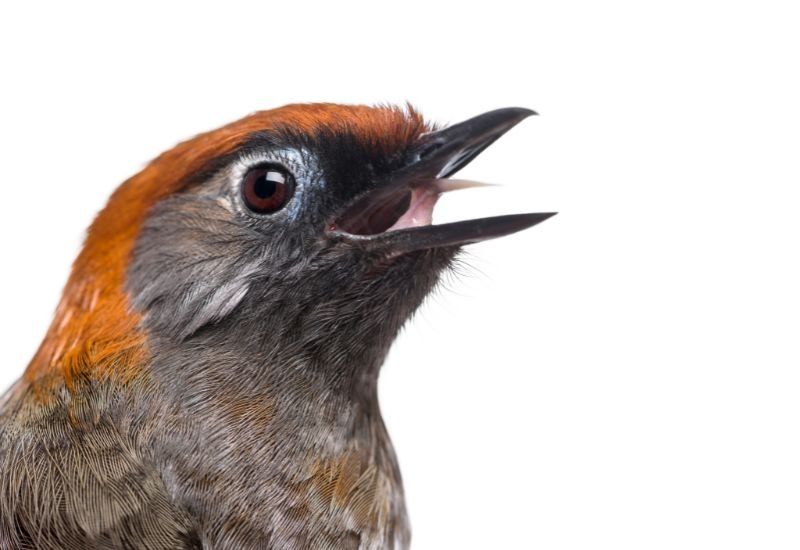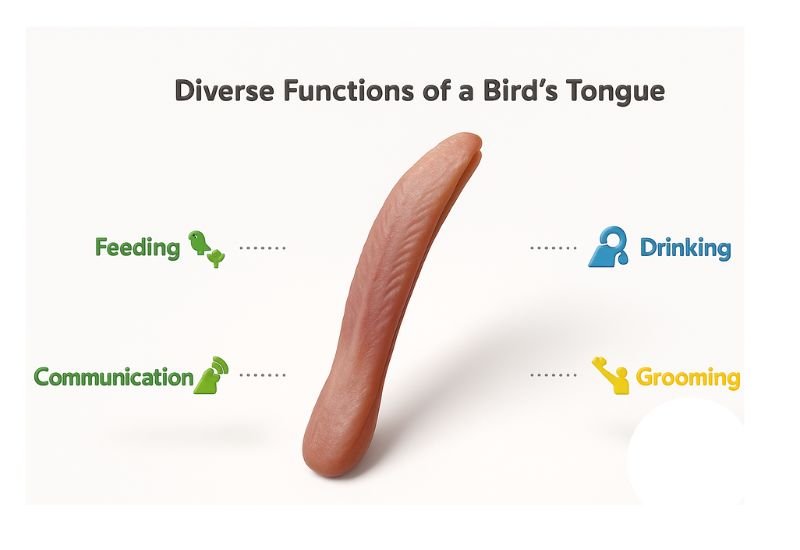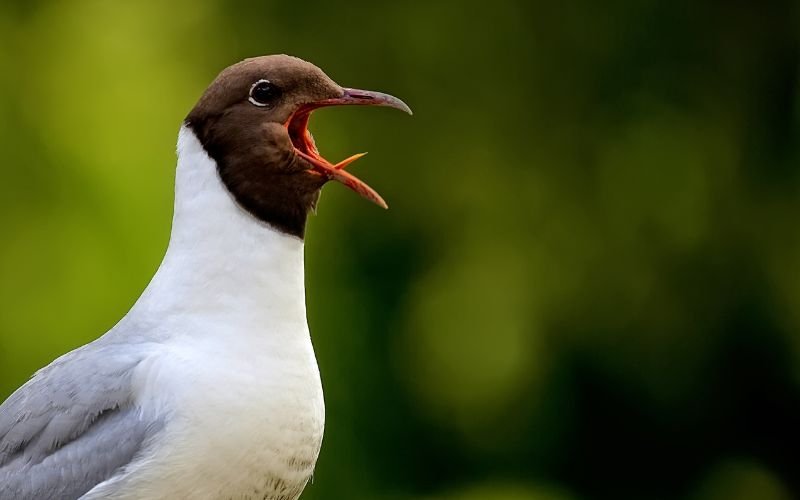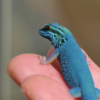- Do Turtles Need Water? - 20 July 2025
- Do Birds Have Tongues? - 14 July 2025
- Can Dogs Swim at Washington Park Denver? - 10 July 2025
Have you ever watched a bird eat or drink from a puddle and wondered how birds can do that? Yes, birds have tongues, but theirs work very differently from ours. Every bird has a distinctive tongue, to accommodate its unique feeding style. In this blog, we’re going to take a journey into the wild world of bird tongues, what they look like, what they do and why they are crucial for birds. Let’s look at some of the interesting details about our feathered friends.
What Do Bird Tongues Look Like?

Bird tongues have special adaptations to suit their feeding habits. Here is a closer look at what makes their tongues so remarkable:
Structure:
Bird tongues are comprised of both bone (the hyoid apparatus) and cartilage, flexible yet rigid. The outer surface is made of keratin that provides strength and shields the tooth against the gradual wear and tear during repeated usage while eating.
Shape Variations:
- Short & Stubby: Chickens have very short tongues which allow them to forage and peck at grains and seeds. This design helps them gather food from the ground rapidly.
- Brush-like: Hummingbirds have brush-like tongues for sipping nectar from flowers. They can quickly protrude and withdraw their tongue, for efficient feeding.
- Spear-like: Woodpeckers have long, spear-like tongues that enable them to poke deeply into tree bark to pull out insects. This shape allows them to sneak into small spaces where their prey may be sheltered.
- Forked: Some parrots have forked tongues, which help them manipulate and hold their food better. It’s a unique design that helps birds keep seeds and fruits in their mouths as they eat.
Taste Buds:
Although birds have fewer taste buds than mammals, they can taste sweet, sour, bitter, and salty tastes too. This powerful sensory sense guides their way to selecting the right kind of food around them, so they obtain healthy food instead of finding poisonous items. These features highlight just how specialized bird tongues are, enabling them to thrive in various habitats and feeding scenarios.
What are the Functions of a Bird’s Tongue?

Feeding
Nectar-feeders like hummingbirds have so-called tube-tongues that can reach deep into the flowers to get nectar. Such an exceptional architecture allows these starlings to feed efficiently when hovering. Insect-eaters are insect only because they have a tongue with barbs on it that can stick into wood when it is covered with sugary resin as performed at creation, and then can pull it out with its full load of insects. Seed-crackers like parrots have very powerful tongues, which aid them in prying open seeds and nuts, making it easy for them to manage fibrous food sources.
Drinking
Pigeons also rely on a special “pumping” mechanism to drink without throwing their heads back, while other birds, including ducks, use their tongues to scoop up water to make it more accessible.
Communication
Birds for example, parrots that utilize their tongues during vocalizing which assists them in imitating sounds and even humans. The use of the tongue can modify the sounds they make and help them communicate.
Grooming
It’s used for feather preening, oiling, and dust cleaning to keep their feathers in good condition. These functions highlight the diversity among bird tongues and suggest their importance not only in eating and drinking but also in communicating and grooming. These functions explain the versatility of bird tongues, showcasing their crucial role in feeding, drinking, communication, and grooming.
Do Birds Have Bones in Their Tongues?
Birds have bones in their tongue called the hyoid apparatus. This is the scaffolding of bones and cartilage that keeps the tongue out so that the tongue can do its job. The hyoid is a flexible structure, and it enables birds to move their tongues forward or backward to collect food, drink, or engage in other activities. This is the basic shape or framework that adaptations have been made upon for the various types of birds and their unique environment.
Do Birds Have Taste Buds on Their Tongues?
Yes, birds do have taste buds on their tongues, but fewer than mammals. Beneath, five things to know about bird taste buds:
- Varied Distribution: The number and location of taste buds can vary significantly between species, with some birds having more concentrated taste buds than others.
- Basic Flavors: Birds can taste basic flavors such as sweet, sour, bitter, and salty, which aids in their food selection.
- Dietary Choices:
- Adaptation: Different species may have specialized taste preferences based on their diets, such as nectar-feeders being more sensitive to sweet flavors.
These features highlight the importance of taste in a bird’s foraging behavior and overall survival.
Dont Miss : Do birds like watermelon?
Differences between Bird and Human Tongues
| Feature | Bird Tongue | Human Tongue |
| Composition | Mostly keratinized | Muscular, covered in taste buds |
| Taste Buds | Few or located deep in mouth | Thousands across surface |
| Use in Vocalization | Assists airflow, especially in parrots | Central to speech and articulation |
| Flexibility | Often rigid or bone-supported | Extremely flexible |
How to Observe Bird Tongues in Nature?
Observing bird tongues in their natural habitat can be a fascinating experience. Here are some tips to help you get started:
- Choose the Right Location: Visit locations where birds commonly feed, such as backyards, parks, wetlands, and forests. Try to find areas that contain a mix of plants, blooms and food sources.
- Use Binoculars: Carry binoculars to watch birds more closely without disturbing them. Then you can see them feeding and flick their tongues better.
- Time Your Visits: Early morning or late afternoon may be the best time for birdwatching since some species are more active at these times. This is when you will probably see feeding behavior.
- Observe Feeding Habits: Identify bird species and what they are eating. For instance, observe hummingbirds as they hover and drink nectar, or see woodpeckers pecking at tree bark in search of insects.
- Be Patient and Quiet: Stay as quiet as possible to avoid scaring the birds away. Patience is key; you may need to wait for the right moment to see their tongues in action.
- Take Notes or Sketches: Record what you observe in notes or with a sketch. You do this to recall the specific words used to describe the birds and their tongue actions.
- Use Field Guides or Apps: Get to know some local bird species with the help of regional field guides or bird survey apps. This information will also enable you to recognize some birds and be more informed about their feeding habits.
- Join Birdwatching Groups: Think about joining birdwatching clubs in your area. Expert birdwatchers could provide tips and also assist you in honing your observation skills.
By following these tips, you can enhance your birdwatching experience and gain a deeper appreciation for the fascinating adaptations of bird tongues in nature.
Final Thoughts
Yes, birds have tongues, and they can do more than just eat or drink and sing with them. Every bird has a tongue designed for its food; that might mean drinking nectar, for example, or crushing seeds. Watching how birds use their tongues could help us learn still more about their lives and appreciate their incredible adaptations.
















